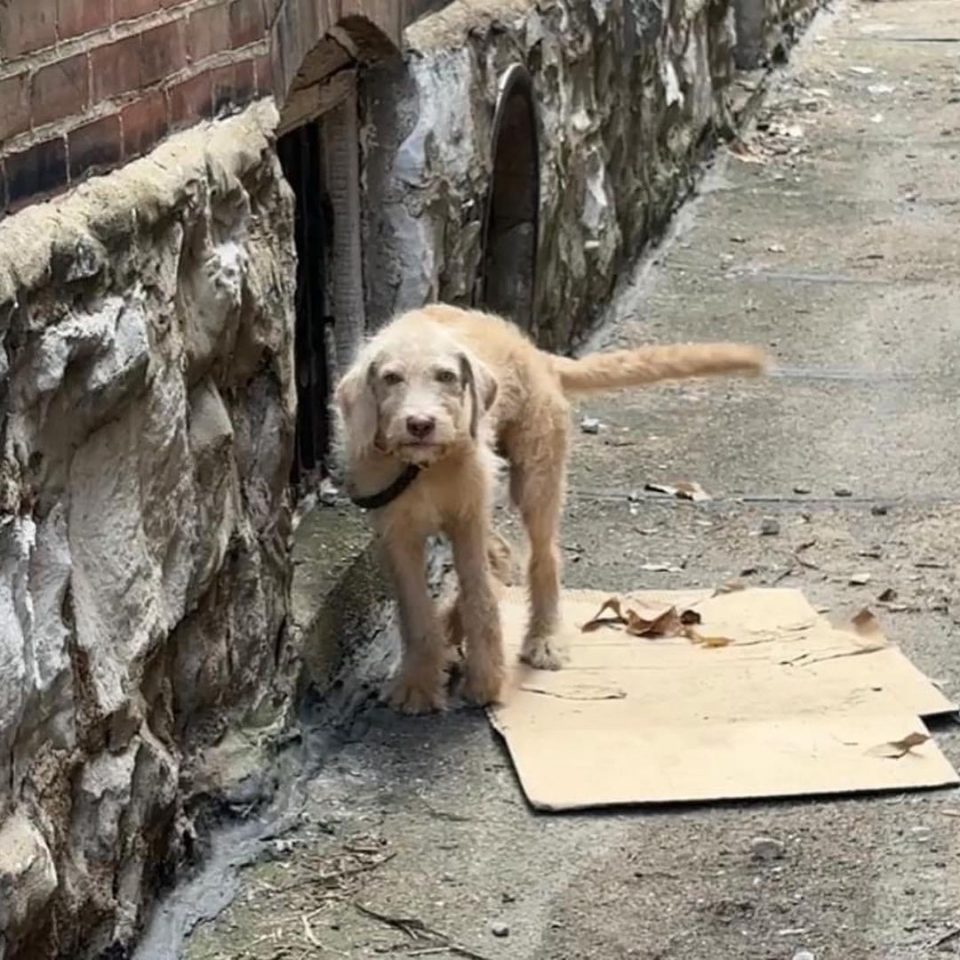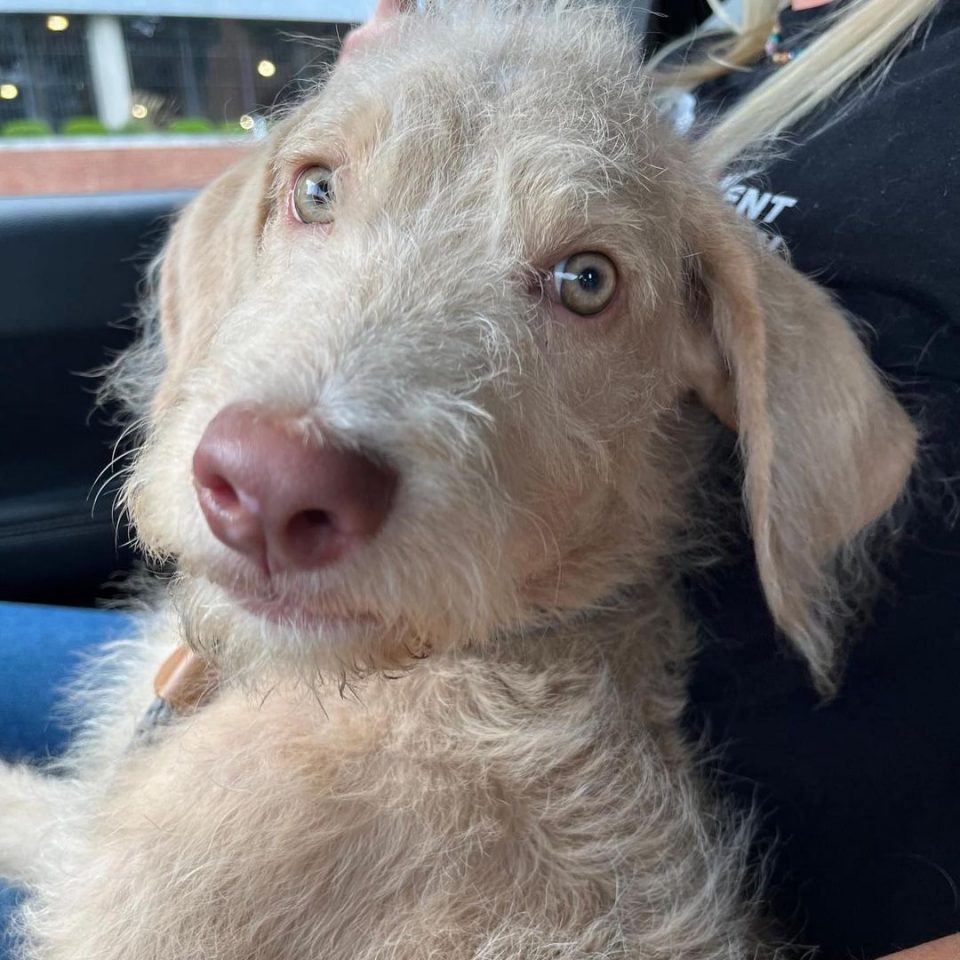We live in a world where countless stray animals roam the streets in search of help, even just a small piece of food and a shred of love. Unfortunately, very few people stop and do something to help.
It’s a heart-wrenching cycle of animals getting constantly abandoned and a handful of kind souls doing everything they can to help.
This is why it’s important to talk about the good things and celebrate people who do help – the ones who risk their lives to save innocent little creatures that do not deserve to be thrown on the street.
If you live in Missouri, then you might have heard of Stray Rescue of St. Louis. Thanks to them, many stray, abandoned, and neglected animals have been granted a second chance – a chance at happiness.
This little baby with a broken leg was luckily one of them. Like many before him, his luck turned around when these kind-hearted rescuers showed up.
The Call To Action

This adorable little puppy with a broken leg was hiding in some bushes behind an abandoned house.
He was terrified and in a lot of pain, so he hid in the bushes to protect himself from the danger of the streets.
If it weren’t for a kind-hearted man and his dog with a keen smell, who knows if anyone would have ever found him?
He was still a little baby.

This Good Samaritan was walking his pup when all of a sudden, she started barking at the bushes, which was very unusual for this dog.
When the man walked over to it, he saw the adorable little face looking at him and pleading for help.
Quickly, the man scooped him up, cradled him in his arms, and carried him to safety, where he kept him secure until the arrival of Stray Rescue of St. Louis.
Donna Lochmann, from the rescue, wasted no time at saving this precious little baby.
All Smiles And A Wagging Tail

Despite being in so much pain for who knows how long, the puppy – later named BlondeBo – was so happy when his rescuers arrived to save him.
His tail was going a hundred miles per hour, but his front leg was in pretty bad shape. He couldn’t walk, so Donna picked BlondeBo up and carried him to the car.
BlondeBo said his goodbye to the Good Samaritan and the dog that found him, and they were on their way to the emergency clinic.
Thankfully, they were able to save his leg.
“At first we feared he would need to lose his leg due to nerve damage from dragging it around. But after some time, he started regaining feeling and using the leg more. We are going to watch him and see how much use he is able to regain use in that leg,” Stray Rescue of St. Louis wrote in their Facebook post.

After a week at the hospital, BlondeBo received the green light to leave the clinic and continue his recovery at a medical foster home.
His foster mom said that he loved rolling around in the grass and was walking, albeit a little clumsily.
Thanks to these kind-hearted people, this furry baby has a chance to live his life full of happiness and love that he craved all along.
To help Stray Rescue of St. Louis save more puppies just like BlondeBo, please visit their website and donate.
If you’ve ever felt the gentle tap of your furry friend’s paw on your leg, you’re not alone. Dogs have a unique way of communicating with us, often using their paws to get our attention. It’s a behavior that can be endearing, but have you ever wondered why your dog does this? Understanding the reasons behind this gesture can give you insight into your canine companion’s thoughts and feelings.
When your dog paws at you, it’s their way of connecting and seeking interaction with you. Whether they’re looking for pets, playtime, or simply craving your attention, this behavior is a clear sign of their desire to engage with you. By deciphering the motivations behind this action, you can strengthen the bond between you and your loyal four-legged friend.
Understanding Canine Communication
The Basics of Dog Body Language
When your furry friend paws at you, it’s crucial to understand the basics of dog body language. Dogs use their paws to communicate various needs or desires. Pawing is a common way for dogs to seek attention, express affection, or request interaction. By recognizing these signals, you can better respond to your dog’s emotional cues and strengthen your bond.
Interpreting Paw Gestures
Interpreting your dog’s paw gestures is key to understanding their communication. A dog may paw at you gently to initiate playtime, seek pets, or simply show that they want to be close to you. In some cases, pawing can also indicate anxiety or a need for comfort. Pay attention to your dog’s overall body language, including tail wagging, ear position, and vocalizations, to decipher the message behind their pawing behavior.
Common Reasons Behind Pawing
Seeking Attention or Affection
When your dog paws at you, it’s often seeking attention or affection. Dogs use their paws to communicate their needs to you. Whether they want a belly rub, a cuddle, or just to be close to you, pawing is their way of showing their affection towards you. Responding positively to this behavior can strengthen the bond between you and your furry friend.
Requesting Something
Your dog may paw at you to ask for something they want. This could be their way of letting you know they are hungry, thirsty, or need to go outside for a potty break. By paying attention to their pawing, you can better understand what they are trying to communicate and meet their needs effectively.
Initiating Play
Pawing can also be a sign that your dog wants to play. Dogs use their paws to engage with you and initiate fun activities. If your dog paws at you during playtime, it’s their way of expressing excitement and eagerness to have a good time with you. Embracing this playful behavior can result in enjoyable and interactive moments with your pet.
Showing Submission or Apology
In some cases, pawing can indicate that your dog is showing submission or apologizing for something. Dogs may paw at you as a way of appeasing you or demonstrating their submissiveness in certain situations. It’s essential to observe your dog’s overall body language and context to interpret whether their pawing signifies submission or an apology.
Behavioral Context of Pawing
What to Look for in Situational Pawing
When your dog paws at you in different situations, pay attention to the context. If your dog paws at you while you’re eating, it might be seeking attention or trying to beg for food. On the other hand, if it paws at you before a walk, it could be excited and eager to go outside. Understanding the specific situations in which your dog paws can help you decipher its intentions better.
Differentiating Between Positive and Negative Pawing
It’s essential to differentiate between positive and negative pawing behaviors in your dog. Positive pawing, such as gently pawing at you for attention or affection, should be acknowledged with positive reinforcement like pets or verbal praise. Conversely, negative pawing, like aggressive pawing or persistent pawing for food, should be redirected through training and rewarded when your dog displays more desirable behaviors. By recognizing and responding accordingly to positive and negative pawing, you can foster a stronger bond with your furry companion.
Responding to Your Dog’s Pawing
How to React Appropriately
When your dog paws at you, it’s essential to respond appropriately to reinforce positive behavior and maintain a healthy relationship. Here’s how you can react effectively:
- Acknowledge and Engage: When your dog paws at you for attention or affection, acknowledge their attempt and engage with them positively. Give them the interaction they seek to show that you value their communication.
- Set Boundaries: If your dog’s pawing becomes excessive or demanding, set clear boundaries to establish respectful behavior. Avoid rewarding persistent pawing to prevent reinforcing unwanted behavior.
- Redirect Focus: When your dog paws at you with a specific request, such as needing to go outside or wanting to play, respond to their needs promptly. Redirect their focus by fulfilling their request or engaging in the desired activity.
Training Tips to Manage Excessive Pawing
Dealing with excessive pawing requires consistent training and positive reinforcement. Here are some tips to help you manage this behavior:
- Teach an Alternative Behavior: Train your dog to perform an alternative behavior, such as sitting or offering a paw on command, to replace excessive pawing. Reward them for displaying the desired behavior to encourage a positive change.
- Use Positive Reinforcement: Reward your dog with treats, praise, or playtime when they refrain from pawing in inappropriate situations. Positive reinforcement helps reinforce good behavior and encourages your dog to follow your cues.
- Seek Professional Help: If excessive pawing persists despite training efforts, consider seeking guidance from a professional dog trainer or behaviorist. They can provide tailored strategies to address the behavior effectively.
By reacting thoughtfully to your dog’s pawing and implementing training techniques, you can foster a harmonious relationship built on clear communication and positive reinforcement.
What to Avoid When Your Dog Paws at You
Negative Reinforcements That Could Backfire
When your dog paws at you, avoid punishing or yelling at them. This can confuse your furry friend and create a negative association with their behavior. Dogs respond better to positive reinforcement; so, opt for rewarding good behavior rather than scolding the unwanted one.
Misinterpreting Your Pet’s Signals
It’s essential not to misinterpret your dog’s pawing as mere attention-seeking behavior. Sometimes, pawing can indicate discomfort, pain, or a medical issue. Instead of assuming, observe your pet’s overall body language and look for any signs of distress or unusual behavior. If in doubt, consult your vet to rule out any underlying health concerns.
Conclusion
Understanding why your dog paws at you is crucial for strengthening your bond and ensuring their well-being. By recognizing their communication cues and responding appropriately, you can address their needs effectively. Remember to use positive reinforcement, set boundaries, and seek professional guidance if necessary. Avoid negative reactions and always consider your dog’s overall well-being. By observing their body language and seeking veterinary advice when needed, you can create a harmonious relationship built on trust and clear communication. Embrace the opportunity to connect with your furry friend on a deeper level and enjoy the unique bond that comes with deciphering their pawing messages. Your dog’s pawing is more than just a gesture – it’s a form of expression that deepens the connection between you both.
Frequently Asked Questions
What does it mean when a dog paws at you?
When a dog paws at you, it could be seeking attention, affection, playtime, or trying to communicate a specific need. It’s essential to observe your dog’s overall body language to understand the context behind the pawing.
How should I respond to my dog’s pawing?
Respond positively to your dog’s pawing when appropriate to reinforce good behavior. Set boundaries for excessive pawing to prevent it from becoming a nuisance. Redirect your dog’s focus when needed to address specific requests or needs effectively.
How can I train my dog to reduce excessive pawing?
Manage excessive pawing by teaching your dog alternative behaviors to replace pawing. Use positive reinforcement techniques to encourage desirable behaviors and discourage excessive pawing. Seek professional help from a trainer or behaviorist if necessary.
What should I avoid when my dog paws at me?
Avoid using negative reinforcements in response to pawing, as it may worsen the behavior or cause confusion. Do not misinterpret your dog’s pawing signals, as it could indicate discomfort, pain, or a medical issue. Observe your dog’s body language and consult a vet if needed for proper evaluation and care.
[no_toc]

Hey there, I’m Janet Brooks, a dog-loving student from California. I’m all about helping pups in need, especially those without homes. Me and my awesome friends work together to give shelter and love to stray dogs. Oh, and I also write blogs about dogs to share helpful info.